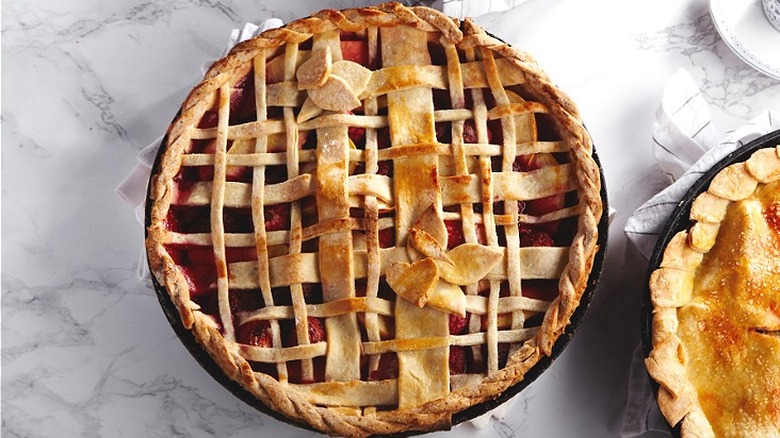Why You Should Be Using Both Butter And Shortening In Pie Crust
The debate over what exactly makes the best pie crust will likely continue for as long as people continue to bake pies. There are bakers who insist a true pie crust is made with 100% butter, and others who swear by pie crust made with vegetable shortening — especially folks who grew up eating pies made their grandmothers and great-grandmothers at a time when Crisco reigned supreme. We'd like to bring peace to pie lovers everywhere by offering a compromise: butter and shortening make a great pie crust. Here's why.
If you love butter, then the benefit of having it in your pie crust is obvious. Sally's Baking Addiction confirms that pie crusts made with butter are rich and flavorful, creating a nice complement to their fillings. Butter has another role in pie crust, too. The water present in cold butter turns to steam as the crust bakes, creating flaky layers and a light texture, just as it does in croissants.
So why bother adding shortening? Epicurious shares that vegetable shortening stays solid at room temperature, making pie dough easier to work with. All-butter pie crust doughs can be tricky, especially for new bakers; if the butter melts before going in the oven, the pie crust will become tough and greasy. A combination of butter and shortening makes your dough easier to handle, but still has lots of delectable flavor.
Using both helps your pie crust design, too
While a pie crust made with only butter can be a bit tricky to work with, it does get easier the more you practice. (And gives you a great excuse to eat more pie!) One thing that pies do lose with all-butter crusts, however, are those Instagram-worthy, intricate designs made with woven lattice strips, delicate cutouts, and tightly crimped edges.
King Arthur Baking Company shares that butter has more water in it than shortening. When that water turns to steam in the oven, it expands, creating a wonderful lift in the crust. Unfortunately, all-butter crust puffs up so much that crimping, cutouts, and woven strips will lose their shape and detail, giving the pie a more rustic look. Because vegetable shortening doesn't melt as fast and has less water, it won't puff the crust like butter. By using a mix of butter and vegetable shortening in the pie crust dough, you get flakiness, taste, texture, and a tidier appearance, too.
As for the ratio of butter to shortening, King Arthur Baking Company goes heavier on the butter in their Classic Double Pie Crust: 10 tablespoons of cold unsalted butter vs. 4 tablespoons of shortening. Sally's Baking Addiction goes the opposite direction, using ¾ cup of shortening and just over ⅓ cup of butter. Feel free to experiment a little to find the ratio of flaky, buttery goodness to tender, stable shortening texture that best suits your pie.

